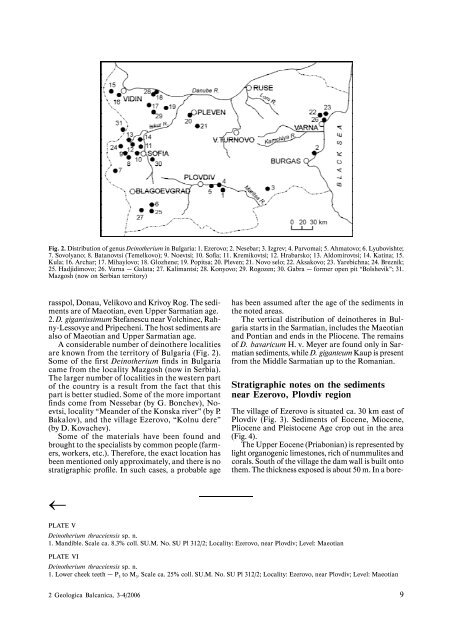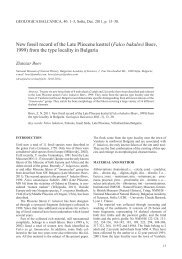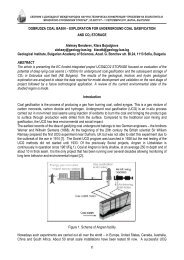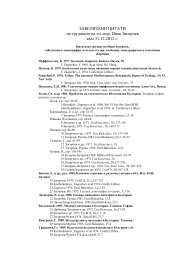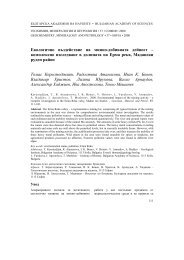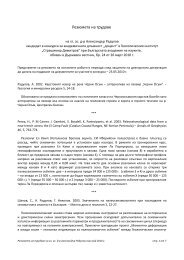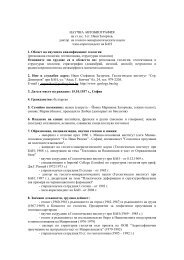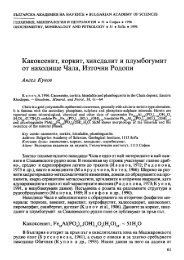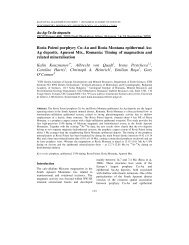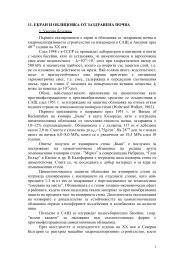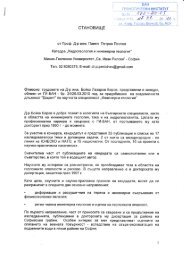Deinotherium thraceiensis sp. nov. from the Miocene near Ezerovo ...
Deinotherium thraceiensis sp. nov. from the Miocene near Ezerovo ...
Deinotherium thraceiensis sp. nov. from the Miocene near Ezerovo ...
You also want an ePaper? Increase the reach of your titles
YUMPU automatically turns print PDFs into web optimized ePapers that Google loves.
Fig. 2. Distribution of genus <strong>Deino<strong>the</strong>rium</strong> in Bulgaria: 1. <strong>Ezerovo</strong>; 2. Nesebar; 3. Izgrev; 4. Parvomai; 5. Ahmatovo; 6. Lyubovishte;<br />
7. Sovolyano; 8. Bata<strong>nov</strong>tsi (Temelkovo); 9. Noevtsi; 10. Sofia; 11. Kremikovtsi; 12. Hrabarsko; 13. Aldomirovtsi; 14. Katina; 15.<br />
Kula; 16. Archar; 17. Mihaylovo; 18. Glozhene; 19. Popitsa; 20. Pleven; 21. Novo selo; 22. Aksakovo; 23. Yarebichna; 24. Breznik;<br />
25. Hadjidimovo; 26. Varna – Galata; 27. Kalimantsi; 28. Konyovo; 29. Rogozen; 30. Gabra – former open pit “Bolshevik”; 31.<br />
Mazgosh (now on Serbian territory)<br />
ras<strong>sp</strong>ol, Donau, Velikovo and Krivoy Rog. The sediments<br />
are of Maeotian, even Upper Sarmatian age.<br />
2. D. gigantissimum Stefanescu <strong>near</strong> Volchinec, Rahny-Lessovye<br />
and Pripecheni. The host sediments are<br />
also of Maeotian and Upper Sarmatian age.<br />
A considerable number of deino<strong>the</strong>re localities<br />
are known <strong>from</strong> <strong>the</strong> territory of Bulgaria (Fig. 2).<br />
Some of <strong>the</strong> first <strong>Deino<strong>the</strong>rium</strong> finds in Bulgaria<br />
came <strong>from</strong> <strong>the</strong> locality Mazgosh (now in Serbia).<br />
The larger number of localities in <strong>the</strong> western part<br />
of <strong>the</strong> country is a result <strong>from</strong> <strong>the</strong> fact that this<br />
part is better studied. Some of <strong>the</strong> more important<br />
finds come <strong>from</strong> Nessebar (by G. Bonchev), Noevtsi,<br />
locality “Meander of <strong>the</strong> Konska river” (by P.<br />
Bakalov), and <strong>the</strong> village <strong>Ezerovo</strong>, “Kolnu dere”<br />
(by D. Kovachev).<br />
Some of <strong>the</strong> materials have been found and<br />
brought to <strong>the</strong> <strong>sp</strong>ecialists by common people (farmers,<br />
workers, etc.). Therefore, <strong>the</strong> exact location has<br />
been mentioned only approximately, and <strong>the</strong>re is no<br />
stratigraphic profile. In such cases, a probable age<br />
←<br />
PLATE V<br />
<strong>Deino<strong>the</strong>rium</strong> <strong>thraceiensis</strong> <strong>sp</strong>. n.<br />
1. Mandible. Scale ca. 8.3% coll. SU.M. No. SU Pl 312/2; Locality: <strong>Ezerovo</strong>, <strong>near</strong> Plovdiv; Level: Maeotian<br />
PLATE VI<br />
<strong>Deino<strong>the</strong>rium</strong> <strong>thraceiensis</strong> <strong>sp</strong>. n.<br />
1. Lower cheek teeth – P 3 to M 3 . Scale ca. 25% coll. SU.M. No. SU Pl 312/2; Locality: <strong>Ezerovo</strong>, <strong>near</strong> Plovdiv; Level: Maeotian<br />
2 Geologica Balcanica, 3-4/2006<br />
has been assumed after <strong>the</strong> age of <strong>the</strong> sediments in<br />
<strong>the</strong> noted areas.<br />
The vertical distribution of deino<strong>the</strong>res in Bulgaria<br />
starts in <strong>the</strong> Sarmatian, includes <strong>the</strong> Maeotian<br />
and Pontian and ends in <strong>the</strong> Pliocene. The remains<br />
of D. bavaricum H. v. Meyer are found only in Sarmatian<br />
sediments, while D. giganteum Kaup is present<br />
<strong>from</strong> <strong>the</strong> Middle Sarmatian up to <strong>the</strong> Romanian.<br />
Stratigraphic notes on <strong>the</strong> sediments<br />
<strong>near</strong> <strong>Ezerovo</strong>, Plovdiv region<br />
The village of <strong>Ezerovo</strong> is situated ca. 30 km east of<br />
Plovdiv (Fig. 3). Sediments of Eocene, <strong>Miocene</strong>,<br />
Pliocene and Pleistocene Age crop out in <strong>the</strong> area<br />
(Fig. 4).<br />
The Upper Eocene (Priabonian) is represented by<br />
light organogenic limestones, rich of nummulites and<br />
corals. South of <strong>the</strong> village <strong>the</strong> dam wall is built onto<br />
<strong>the</strong>m. The thickness exposed is about 50 m. In a bore-<br />
9


